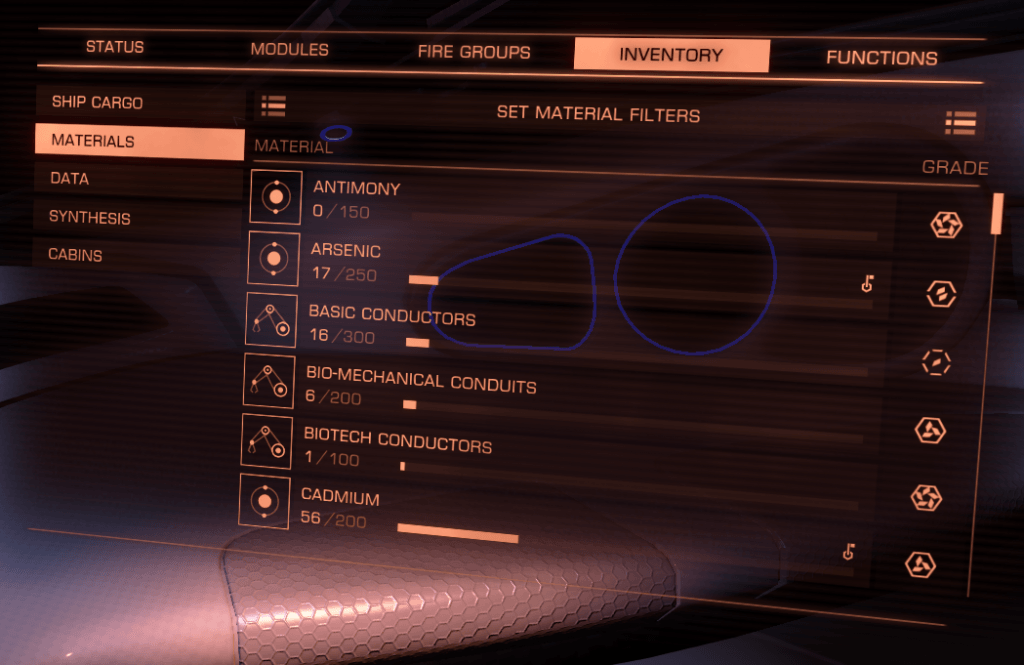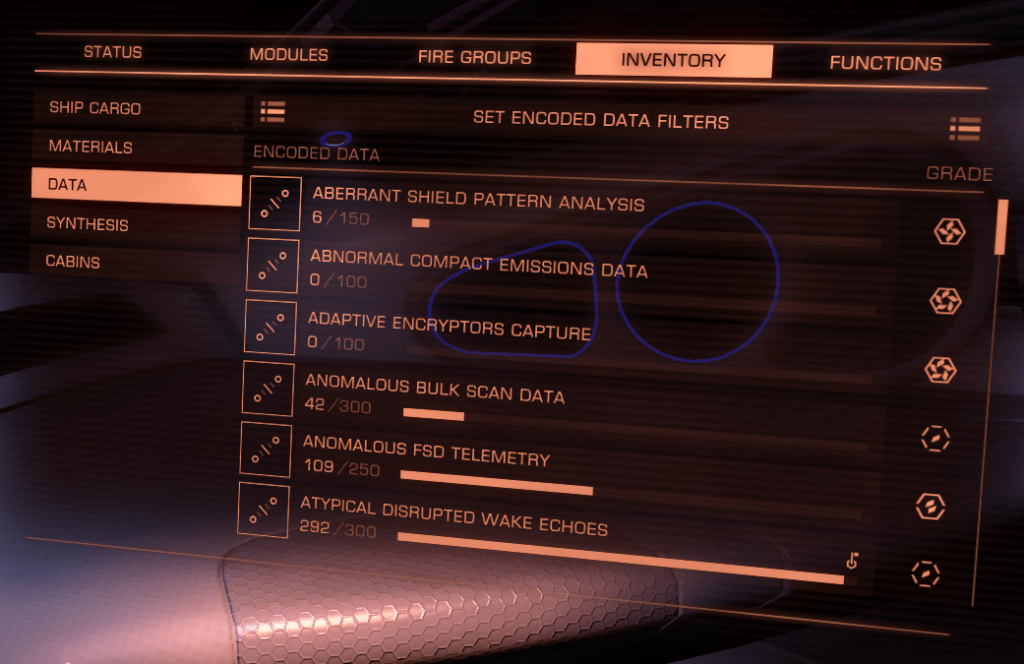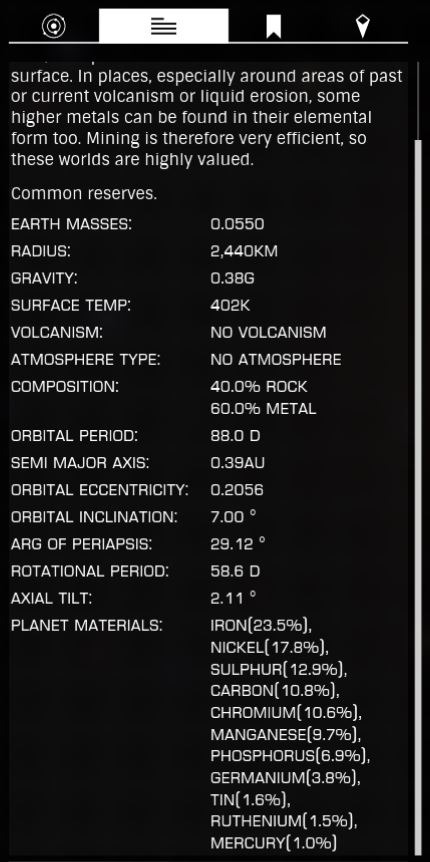What are materials and data?
Materials are recoverable items using the ship’s and the SRV’s cargo scoops. In the case of the ship, it is possible to use collecting drones to retrieve them. Data are downloadable using the scanners of the ship and of the SRV. Materials and data can also be obtained as missions rewards.
Materials and data, unlike the goods do not occupy cargo space, but have a dedicated storage area, which is attached to the CMDR:
- For each recovered item, we actually get 3 units of the material/data (this does not work for mission rewards where it is the number of units that is indicated). In case of destruction of the ship, the materials and data are never lost
- Each type of material/data has a rarity level (from 1 very common to 5 very rare)
- Each type of material/data has an individual storage limit in number of units, all the more important as its rarity is low
Icon Rarity Storage limit

Very Common 300 units

Common 250 units

Standard 200 units

Rare 150 units

Very Rare 100 units
There are 2 types of materials, with different harvesting methods and locations:
- The elements are natural chemical elements (Arsenic, Manganese,…).
- Manufactured materials are industry-manufactured components (galvanic alloys, compact composites,…)
What is the purpose of materials/data?
Materials and data are used in different combinations to:
Improve modules
- For each module it has several blueprints
- Each blueprint is available with one or more engineers, in their planetary bases
- For each blueprint there are up to 5 grades
- Each blueprint-grade crossing has its own “recipe” in materials/data
- Moreover for each blueprint there may be “special effects”, which also have their recipe
- The engineering of the modules for the exploration is processed in the page Outfitting and engineering its vessels for Exploration
Unlock modules from technology brokers
- Providing a given a list of materials/data it is possible to obtain access to special modules from the technology brokers
- Once unlocked, each special module can be purchased and equipped like any other module
- There are two types: human and guardian
- The interesting modules to unlock for exploration are described in the page Outfitting and engineering its vessels for Exploration
Synthesis
- It can be carried out in the ship, and each also have their recipe in materials (no data)
- It allows reloading ammunition for modules
- There are up to 3 levels of synthesis for one type of ammunition (basic, intermediate, premium). The best level for improved ammunition in addition to reloading
- One of the syntheses: The FSD Injection, allows to increase the FSD jump range of next jump (+ 25%, + 52% or + 100%)
- In addition to FSD injections, SRV repair, SRV fuel reloading, SRV ammo reloading, and MTA reloading synthesis are very useful to explorers
Manage your stock of materials/data
Know your stock in game
In the cockpit interface (at right) there is a screen for the materials and one for the data, allowing to know and manage its stocks.


In both cases, it is possible to filter the materials/data displayed, by rarity level or by type:

External Tools
There are a number of websites/tools for managing materials and their use. Here are the three most well-known and complete:
- EDEngineer is a PC software dedicated to this. It is very complete.
- The INARA website lists the types of materials, the engineers and the recipes
- The EDBoard website offers an equivalent of the information of INARA.
Material Traders
It is possible to exchange materials or data against others. There is always a loss, but it makes it possible to exchange unnecessary materials/data against those we need. For this you have to go to a material trader in the Contacts section of some stations. There are three types of material trader:
- Those for the elements, are located in the stations of Extraction or Refinery Economy
- Those for manufactured materials, are located in Industrial economy stations
- Those for data, are located in High-tech or Military economy stations
In any case, in order to have a material trader in station (this is also true for the presence of technology brokers), it is necessary to have:
- Medium or High security
- Population between 1 000 000 and 22 000 000
- Not in anarchic systems
- Not in stations controlled by a criminal faction
- Not in damaged or under repair stations, or in Lockdown
The EDSM website (facilities criteria) also allows to do a search of systems hosting material trader and/or technology brokers.
Where to harvest elements?
Planetary Surface
The most classic source of materials are the landable planets. To find out what elements a planet has, it is necessary to scan it with the FSS (Full System Scanner). This gives the list of the elements it contains with their proportions. This information is available directly in the FSS interface (top right, 3 scrolling screens), but also in the system map (second tab).


To collect the elements, you have to land on the surface, and deploy your SRV for:
- Finding deposits (using the SRV radar)
- Destroy them (using the SRV lasers)
- Harvest them (rolling over them, with the cargo scoop open)
Each item collected gives 3 units.
To find the deposits you have to use the SRV radar. Each type of deposit has its own energy signature on the radar, and a characteristic sound.

The WaveScanner website allows you to learn how to recognize them (and to distinguish them from human or extraterrestrial signals).
Each planet contains exactly:
- 1 very rare or rare element
- 2 Standard elements
- 3 Common elements
- All very common elements (except on the metal-rich planets where there is only Nickel and Iron)
Depending on the type of deposit the probability of obtaining rare or very rare fragments is variable:
- Meteorite Bronzite-Chondrite: Low
- Type 1 outcrop (outcrop 1): Low
- Type 2 outcrop (outcrop 2, Metallic): Average
- Mesosiderite Meteorite: High
- Metallic Meteorite: Very high
Meteorites often appear in groups of 2 or 3.
Each once-destroyed deposit provides approximately 4 to 8 fragments.
Planetary POI
Geological planetary (geysers, fumaroles,…) or biological (Brain Trees, Pumkins,…) points of interest are good areas for collecting materials. Indeed on a part of the formations (geysers for example), there are crystals (for geological POI) or biological formations (for biological POI), which when one shoots it unhook and provide a fragment of material. The materials are those of the planet, and have a good proportion of rare/very rare (and regenerate slowly, avoiding having to do disconnection-reconnection).
Some planetary POIs of human origin also allow the harvesting of rare elements, especially the crushed vessels that contain cargo racks that can be destroyed in SRV then releasing elements. It is possible to find it on the Canonn website. One of the best known is:
The Barnacles (Thargoid structures) and to a lesser extent the Thargoid bases contain spikes, which once destroyed also provide the elements of the planet. The advantage is that there are many for each barnacle. It is necessary to provide disconnection-reconnection, or round trips in supercruise to regenerate the spikes.
Planetary POIs are probably the fastest way to collect elements.
Asteroid mining
When mining in asteroids, in addition to the refined fragments, each asteroid provides between 0 and 5 materials.
Warning: There are no rare or very rare elements in asteroids.
Mission Reward
Some missions give elements as rewards. Usually 1 to 5 units.
Where to harvest manufactured materials?
Destroying NPC ships
A number of manufactured materials are dropped when an NPC ship is destroyed. The types of materials dropped depend on the type of vessel.
Transport vessels (hauler, Adder, T6, T7, T9):
- Very common: Basic Conductors, Chemical Storage Units, Heat Conduction Wiring, Mechanical Scrap
- Common: Chemical Processors, Conductive Components, Heat Dispersion Plate, Mechanical Equipment
- Standard: Chemical Distillery, Conductive Ceramics, Heat Exchangers, Mechanical Components
- Rare: Chemical Manipulators, Conductive Polymers, Configurable components, Heat Vanes
Combat vessels (wanted NPC ships):
- Very common: Salvaged Alloys, Worn Shield Emitters, Crystal Shards, Tempered Alloys
- Common: Flawed Focus Crystals, Galvanizing Alloys, Shield Emitters
- Standard: Shielding Sensors, Focus Crystals, Phase Alloys
- Rare: Thermic Alloys, Compound Shielding
- Very rare: Exquisite Focus Crystals, Core Dynamics Composites
Military vessels/Authorities (interceptions or war zones):
- Very common: Grid Resistors
- Common: Hybrid Capacitors, Filament Composites, Heat Resistant Ceramics
- Standard: Electrochemical Arrays, High Density Composites, Precipitated Alloys
- Rare: Polymer Capacitors
Unidentified Signal Sources
A number of manufactured materials can be found directly in unidentified signal sources.
Any Sources:
- Very common: Compact Composites, Grid Resistors, Heat Conduction Wiring, Mechanical Scrap, Worn Shield Emitters
- Common: Chemical Processors, Filament Composites, Galvanizing Alloys, Heat Dispersion Plate, Hybrid Capacitors, Mechanical Equipment, Shield Emitters
- Standard: Chemical Distillery, Focus Crystals, High Density Composites, Phase Alloys, Shielding Sensors
- Rare: Heat Vanes
Convoy Dispersal Pattern:
- Rare: Chemical Manipulators, Polymer Capacitors
Combat Aftermath:
- Very common: Salvaged Alloys
- Common: Flawed Focus Crystals
- Standard: Mechanical Components
- Rare: Configurable Components
Encoded Emissions:
- Rare: Compound Shielding, Configurable Components, Proprietary Composites
Degraded emissions (anarchic systems):
- Common: Conductive Components
- Standard: Conductive Ceramics, Electrochemical Arrays, Heat Exchangers
Weapon Fire:
- Rare: Refined Focus Crystals
High Grade Emissions:
- Rare: Proprietary Composites (Federal systems), Proto Light Alloys (Boom systems)
- Very rare: Core Dynamics Composites (Federal systems), Imperial Shielding (imperial systems), Military Grade Alloys (systems at war or civil war), Military Supercapacitors (systems at war), Proto Heat Radiators (Boom systems), Proto Radiolic Alloys (Boom systems)
In planetary POIs of human origin
It is possible to find many manufactured materials.
Some planetary POIs of human origin also allow the harvesting of manufactured materials, especially the abandoned planetary bases, where many manufactured materials litter The ground, and are recoverable in SRV. It is possible to find it on the Canonn website. One of the best known is:
Planetary POIs are probably the fastest method for harvesting manufactured materials. Disconnections/reconnections or round trips in supercruise allow to refresh the instance. These bases are all the materials usually dropped during the destruction of vessels (all types).
Guardian and Thargoid sites
Guardian manufactured materials are harvestable exclusively on Guardian bases:
- Very common: Guardian Wreckage Components, Guardian Power Cell
- Common: Guardian Power Conduit,
- Standard: Guardian Sentinel Weapon Parts, Guardian Technology Component
Some components require the destruction of Gardian sentinels (which retaliate).
Thargoid manufactured materials are harvestable exclusively on Thargoid bases:
- Common: Thargoid Carapace
- Standard: Thargoid Energy Cell
- Rare: Thargoid Technological Components
- Very rare: Thargoid Organic Circuitry
Some components need to destroy Thargoid sentinels (which retaliate).
Mission Reward
Some missions give manufactured materials as a reward. Usually 1 to 5 units.
Where to scan data?
Scanning ships
Scanning ships, either in supercruise or in normal space, gives regular data.
Transport vessels:
- Very common: Anomalous Bulk Scan Data, Distorted Shield Cycle Recordings
- Common: Inconsistant Shield Soak Analysis, Unidentified Scan Archives
- Standard: Classified Scan Databanks
Combat vessels (wanted NPC ships ):
- Standard: Unexpected Emission Data, Untypical Shield Scans
- Rare: Aberrant Shield Pattern Analysis, Decoded Emission Data
- Very rare: Abnormal Compact Emissions Data
Military vessels/Authorities (intercept or war zones):
- Very Rare: Classified Scan Fragment
Unidentified Signal Sources
A number of data can be scanned in unidentified signal sources.
Any Sources:
- Very common: Exceptional Scrambled Emission Data, Specialized Legacy Firmware, Uunusual Encrypted Files
- Common: Irregular Emission Data, Modified consumer Firmware, Tagged encryption Codes
- Standard: Open Symmetric Keys, Unexpected Emission Data
- Very rare: Adaptive Encryptors Capture
Encoded Emissions:
- Very rare: Datamined Wake Exceptions, Abnormal Compact Emissions Data
Satellites present in different types of space POI also give data.
FSD Wake Scan
The only way to obtain certain data is to scan the FSD wakes left by the vessels making a jump. For this it is necessary to equip on its vessels a FSD wake scanner.
The data concerned are:
- Very common: Atypical Disrupted Wake Echoes
- Common: Anomalous FSD Telemetry
- Standard: Strange Wake Solutions
- Rare: Eccentric Hyperspace Trajectories
- Very rare: Datamined Wake Exceptions
In planetary bases and planetary POI of human origin
Data can be obtained by scanning the data points in SRV, present either on an active basis or on an abandoned basis.
Planetary bases are visible from the system map (icons other than stations).

The EDPathFinder software allows to locate interesting bases to scan. A relog is enough to scan the same data point for planetary bases. This software uses your logs to offer you a database not already scanned recently.
The following data can be scanned on the data points of the planetary bases:
- Very common: Specialized Legacy Firmware, Unusual Encrypted Files
- Common: Modified Consumer Firmware, Tagged Encryption Codes
- Standard: Cracked Industrial Firmware, Open Symmetric Keys
- Rare: Divergent Scan Data, Security Firmware Patch
- Very rare: Classified Scan Fragment, Modified Embedded Firmware
Some planetary POIs of human origin (abandoned bases) allow the scan of data points in SRV. It is possible to find it on the Canonn website.
Guardian and Thargoid sites
Guardian data are harvestable exclusively on Guardian bases:
- Very common: Pattern Gamma Obelisk Data
- Common: Pattern Beta Obelisk Data
- Standard: Pattern Alpha Obelisk Data
- Rare: Delta Obelisk Data Pattern
- Very rare: Guardian Module Blueprint Segment, Guardian Vessel Blueprint Segment, Guardian Weapon Blueprint Segment, Pattern Epsilon Obelisk Data
Thargoids data are harvestable exclusively on Thargoid bases:
- Common: Thargoid Structural Data
- Standard: Thargoid Material Composition Data, Thargoid Ship Signature
- Rare: Thargoid Residue Data, Thargoid Wake Data
Mission Reward
Some missions give data as a reward. Usually 1 to 5 units.